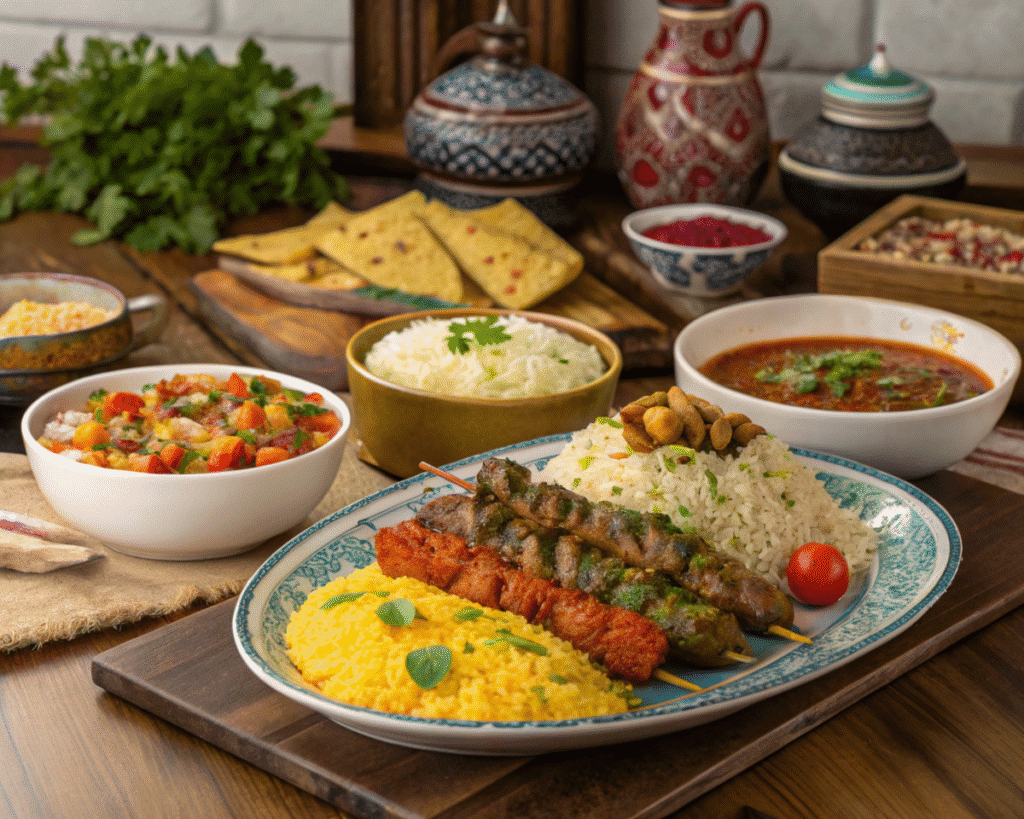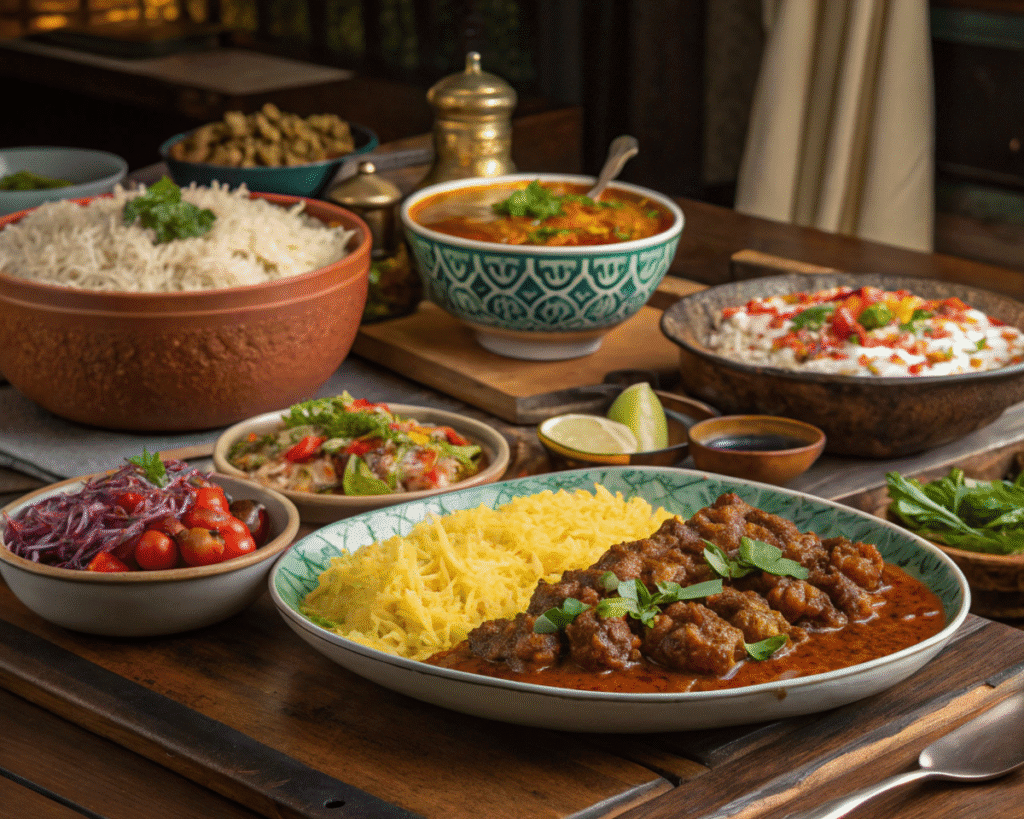Iran cuisine recipes offer a vibrant tapestry of flavors, aromas, and traditions that reflect the country’s rich history and diverse geography. From fragrant rice dishes to succulent kebabs and hearty stews, Persian cuisine captivates food lovers worldwide. This article explores the origins of Iran cuisine, how to prepare authentic recipes, their nutritional benefits, and essential insights into this ancient culinary tradition.

Origins of Iran Cuisine Recipes
Iran cuisine recipes trace their roots to ancient Persia, one of the world’s oldest civilizations. Persian food draws inspiration from the Silk Road, blending influences from Central Asia, the Middle East, and the Mediterranean. Over centuries, Iran’s diverse regions—mountains, deserts, and coastal areas—shaped its cuisine, incorporating local ingredients like saffron, pomegranates, and herbs.
The Achaemenid Empire (550–330 BCE) introduced sophisticated cooking techniques, emphasizing balanced flavors. Later, the Safavid dynasty (1501–1736) elevated Persian cuisine with refined rice dishes and intricate stews. Today, Iran cuisine recipes remain a cornerstone of cultural identity, celebrated for their complexity and harmony.
Key Ingredients in Iran Cuisine Recipes
Iran cuisine recipes rely on fresh, aromatic ingredients that create depth and balance. Common components include:
- Saffron: Known as “red gold,” saffron imparts a golden hue and earthy flavor to rice and stews.
- Rice: Long-grain basmati rice forms the backbone of dishes like tahchin and zereshk polo.
- Herbs: Parsley, cilantro, dill, and mint add freshness to stews and side dishes.
- Pomegranates: Used in sauces like fesenjan, pomegranates bring a sweet-tart balance.
- Dried Fruits: Barberries, apricots, and raisins enhance sweet-savory profiles.
- Nuts: Almonds, pistachios, and walnuts add texture and richness.
- Spices: Turmeric, cinnamon, and cardamom create warmth and complexity.
These ingredients reflect Iran’s agricultural abundance and its knack for combining sweet, sour, and savory elements.
Popular Iran Cuisine Recipes
Here are five authentic Iran cuisine recipes, complete with step-by-step instructions, to bring Persian flavors to your kitchen.
1. Ghormeh Sabzi (Herb Stew)
Ghormeh sabzi is Iran’s national dish, a fragrant stew packed with herbs, kidney beans, and lamb. It’s a staple in Persian households, known for its tangy, herbaceous flavor.
Ingredients (Serves 4)
- 500g lamb shoulder, cubed
- 1 cup red kidney beans, soaked overnight
- 2 cups chopped parsley
- 1 cup chopped cilantro
- 1 cup chopped spinach
- 1/2 cup chopped green onions
- 4 dried limes (limoo amani), pierced
- 1 large onion, diced
- 3 tbsp vegetable oil
- 1 tsp turmeric
- Salt and pepper to taste
- Water
Instructions
- Heat oil in a large pot over medium heat. Sauté the onion until golden.
- Add lamb cubes and turmeric. Cook until browned, about 8 minutes.
- Stir in kidney beans and 4 cups of water. Bring to a boil, then simmer for 1 hour.
- Add chopped herbs and dried limes. Simmer for another 45 minutes, stirring occasionally.
- Season with salt and pepper. Cook until the lamb is tender and the stew thickens, about 15 minutes.
- Serve hot with basmati rice.
Cooking Tip
Pierce dried limes to release their tangy flavor without breaking them apart.
2. Zereshk Polo (Barberry Rice with Chicken)
Zereshk polo combines fluffy basmati rice with tart barberries and tender chicken, topped with saffron for elegance.
Ingredients (Serves 4)
- 2 cups basmati rice
- 4 chicken thighs, bone-in
- 1/2 cup dried barberries (zereshk)
- 1 large onion, sliced
- 2 tbsp butter
- 1 tsp saffron threads, soaked in 2 tbsp hot water
- 1 tbsp sugar
- 3 tbsp vegetable oil
- Salt and pepper to taste

Instructions
- Rinse rice until water runs clear. Soak in salted water for 1 hour.
- Heat oil in a skillet. Cook chicken thighs with onion, salt, and pepper until golden, about 10 minutes.
- Add 1 cup water to the skillet. Simmer chicken for 30 minutes until cooked.
- Boil soaked rice in salted water for 8 minutes. Drain and set aside.
- In a non-stick pot, layer half the rice, chicken, and remaining rice. Steam over low heat for 30 minutes.
- Sauté barberries with butter and sugar for 2 minutes. Stir gently to avoid crushing.
- Serve rice topped with barberries and a drizzle of saffron water.
Cooking Tip
Soak barberries briefly to remove dust, but don’t oversoak to preserve their tartness.
3. Fesenjan (Pomegranate Walnut Stew)
Fesenjan is a luxurious stew featuring pomegranate molasses, walnuts, and chicken, offering a perfect sweet-sour balance.
Ingredients (Serves 4)
- 500g chicken breast, cubed
- 2 cups walnuts, finely ground
- 1 cup pomegranate molasses
- 1 large onion, diced
- 2 tbsp vegetable oil
- 1 tsp turmeric
- 1 tbsp sugar (optional)
- Salt to taste
- Water
Instructions
- Heat oil in a pot. Sauté onion until soft, about 5 minutes.
- Add ground walnuts and turmeric. Stir for 3 minutes to toast.
- Pour in 3 cups of water. Simmer for 30 minutes, stirring occasionally.
- Add chicken and pomegranate molasses. Cook for 45 minutes until the sauce thickens.
- Adjust flavor with sugar and salt. Simmer for 10 more minutes.
- Serve with basmati rice.
Cooking Tip
Grind walnuts finely to achieve a smooth, creamy texture for the sauce.
4. Tahchin (Saffron Rice Cake)
Tahchin is a showstopping dish with a golden saffron crust, layered with yogurt-marinated chicken and rice.
Ingredients (Serves 4)
- 2 cups basmati rice
- 2 chicken breasts, cooked and shredded
- 1 cup plain yogurt
- 1 tsp saffron threads, soaked in 2 tbsp hot water
- 2 egg yolks
- 3 tbsp butter
- 1 tbsp vegetable oil
- Salt to taste
Instructions
- Rinse and soak rice in salted water for 1 hour.
- Mix yogurt, egg yolks, half the saffron water, and salt. Marinate shredded chicken in this mixture for 30 minutes.
- Parboil rice for 8 minutes. Drain and set aside.
- Melt butter and oil in a non-stick pot. Spread a layer of rice mixed with remaining saffron water at the bottom.
- Layer half the marinated chicken, then half the rice. Repeat layers.
- Cover and cook on low heat for 1 hour until a golden crust forms.
- Invert onto a platter to reveal the crust. Slice and serve.
Cooking Tip
Use a non-stick pot to ensure the tahdig (crispy rice layer) releases easily.
5. Kuku Sabzi (Herb Frittata)
Kuku sabzi is a herb-packed frittata, perfect as a light meal or appetizer.
Ingredients (Serves 4)
- 6 eggs
- 1 cup chopped parsley
- 1 cup chopped cilantro
- 1/2 cup chopped dill
- 1/2 cup chopped green onions
- 1 tbsp dried barberries (optional)
- 1 tsp turmeric
- 2 tbsp vegetable oil
- Salt and pepper to taste
Instructions
- Whisk eggs with turmeric, salt, and pepper.
- Stir in chopped herbs and barberries.
- Heat oil in a non-stick skillet over medium heat.
- Pour egg mixture into the skillet. Cook for 8 minutes until the edges set.
- Flip or finish under a broiler for 3 minutes until fully cooked.
- Slice into wedges and serve warm or cold.
Cooking Tip
Chop herbs finely for even distribution and a cohesive texture.
Nutritional Values of Iran Cuisine Recipes
Iran cuisine recipes emphasize fresh ingredients, offering a balance of nutrients. Here’s a breakdown of their health benefits:
- Protein: Lamb, chicken, and beans in dishes like ghormeh sabzi and fesenjan provide high-quality protein for muscle repair and energy.
- Fiber: Herbs, legumes, and dried fruits contribute dietary fiber, aiding digestion and heart health.
- Healthy Fats: Walnuts and olive oil supply monounsaturated fats, supporting cardiovascular health.
- Vitamins and Minerals: Fresh herbs like parsley and cilantro offer vitamins A, C, and K, while pomegranates provide antioxidants.
- Low Sugar: Most recipes rely on natural sweetness from fruits, reducing refined sugar intake.
Nutritional Highlights
- Ghormeh Sabzi: Rich in iron from lamb and vitamin C from herbs.
- Zereshk Polo: Barberries provide antioxidants; chicken offers lean protein.
- Fesenjan: Walnuts supply omega-3 fatty acids; pomegranates reduce inflammation.
- Tahchin: Yogurt adds probiotics; saffron contains mood-boosting compounds.
- Kuku Sabzi: Eggs provide choline; herbs boost immune function.
Portion control is key, as some dishes, like fesenjan, are calorie-dense due to nuts and oils. Pairing with vegetables or small rice portions enhances balance.
Cultural Significance of Iran Cuisine Recipes
Iran cuisine recipes are more than food—they’re a celebration of community and heritage. Meals often center around family gatherings, with dishes like zereshk polo served during Nowruz (Persian New Year). The art of tahdig—the crispy rice crust—showcases culinary skill and is a point of pride.
Persian hospitality emphasizes abundance, with tables laden with colorful dishes. Sharing food fosters connection, reflecting Iran’s communal values. Recipes also vary by region: northern Iran favors fish and garlic, while southern dishes lean spicier.
Tips for Mastering Iran Cuisine Recipes
- Source Quality Ingredients: Invest in high-quality saffron and basmati rice for authentic flavor.
- Balance Flavors: Persian cuisine thrives on sweet-sour-savory harmony. Taste and adjust seasonings.
- Master Rice Cooking: Achieve fluffy rice by rinsing thoroughly and steaming properly.
- Use Fresh Herbs: Dried herbs can’t replicate the vibrancy of fresh parsley or dill.
- Experiment with Substitutions: Swap lamb for beef or tofu for vegetarian versions.
Pairing Iran Cuisine Recipes with Sides
Complement these dishes with traditional sides:
- Mast-o-Khiar: A yogurt-cucumber dip with mint.
- Sabzi Khordan: A platter of fresh herbs, radishes, and feta.
- Torshi: Pickled vegetables for a tangy contrast.
- Doogh: A refreshing yogurt drink with dried mint.
Storing and Reheating Iran Cuisine Recipes
- Storage: Store stews and rice dishes in airtight containers in the fridge for up to 4 days.
- Freezing: Ghormeh sabzi and fesenjan freeze well for up to 3 months. Avoid freezing rice dishes to maintain texture.
- Reheating: Gently reheat stews on the stovetop with a splash of water. Microwave rice with a damp paper towel to retain moisture.
Exploring Iran Cuisine Recipes Beyond the Basics
For adventurous cooks, try these advanced dishes:
- Baghali Polo: Rice with fava beans and dill, often paired with lamb shank.
- Khoresh Bademjan: Eggplant and tomato stew with beef.
- Ash Reshteh: A hearty noodle soup with beans, herbs, and kashk (fermented whey).
Each dish showcases Iran’s knack for layering flavors and textures.
Where to Find Authentic Ingredients
Source ingredients from:
- Local Middle Eastern Markets: Stock saffron, dried limes, and barberries.
- Online Retailers: Websites like PersianBasket or Kalustyan’s offer Persian staples.
- Farmers’ Markets: Fresh herbs and pomegranates are often available seasonally.
Iran cuisine recipes invite you to explore a world of bold flavors and time-honored traditions. From the herb-infused ghormeh sabzi to the golden-crusted tahchin, these dishes offer something for every palate. Their nutritional benefits, rooted in fresh ingredients and balanced flavors, make them a wholesome choice. By mastering these recipes, you’ll bring a piece of Persia’s culinary heritage to your table, creating meals that nourish both body and soul.

